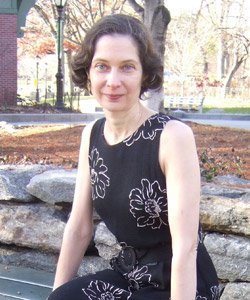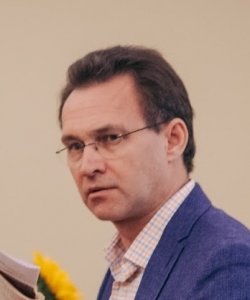25 Оctober 2017 - Session 1
-

Natalia Sipovskaia
«The Great Hall on the Yauza». The Lefortovsky Palace as a Political Démarche
The Lefortovsky Palace on the Yauza River is one of the most famous buildings of the Petrine Moscow and the first construction initiative of the young tsar. The palace was built by Peter the Great for Franz Lefort, the closest supporter of his forthcoming reforms. His contemporaries, however, were not misled by this supposedly private designation. In documents of the period this project appears as royal order. The most interesting aspect of these documents is that often they describe the project not as a construction of a palace or a house, but that of a “great dining hall,” around and for which the palace was built. This great dining hall, intended for ceremonial occasions, became the kernel and the largest area of the initial building by Dmitrii Askamitov. In accordance with European tradition, the palace was symmetrical, with enfilades of rooms on the sides. It inherited Russian tradition in both its pointed roofs and in its conceptual logic. In tsar’s residences, large spaces for various state affairs and social gatherings were built separately. One of the most obvious examples of the Palace of the Facets in Moscow’s Kremlin (1487-1491).
Archival materials relating to the construction of Lefortovsky Palace draw attention to this little-known example. These documents state with unusual frequency the exact dimensions of the great dining hall. Translated into today’s metric system, they are 18 by 18 meters (324 cubic meters) and 10 meters high. These numbers are impressive not least because they repeat the proportions of the Palace of the Facets – 17.5 x 17.5 meters and 9 meters high – only with a slight increase in size. In this case, it is quite possible that this building, which served as the main reception hall for the tsars of Moscow, was consciously or unconsciously present in the mind of the new tsar who decided to erect his ceremonial hall at the new “German” location, outside of the Kremlin walls. My paper will present an argument in support of this proposition. -

Margaret Samu
The French Reception of Karl Briullov’s Last Day of Pompeii
Karl Briullov’s Last Day of Pompeii (1833) is, by any standard, the most famous Russian painting of the first half of the nineteenth century. Most accounts of the painting’s European reception discuss its critical and popular success in Italy and its subsequent gold medal at the Paris Salon of 1834. They also quote the progressive Parisian critics who dismissed the painting as outdated melodrama. Bruillov’s European triumph explains his dominance in Russian academic painting during the decades. By tempering Briullov’s success among conservative audiences with mockery in the forward-looking popular press, the standard narrative demonstrates the belatedness and stagnation of the Russian art world in order to set the stage for the breakthrough of Russian realism.
This paper will examine instead what Briullov’s masterpiece meant to French viewers. It will compare Pompeii to other contemporaneous gold medal winners in light of the Salon jury’s evaluations. It will also consider current ideas in French art and visual culture to gain new insights into the discrepancy between the jury’s and critics’ verdicts. Engaging in close examination of the painting and investigating previously untapped primary sources, it will shed new light on what was at stake during the July Monarchy for the Salon jury to award its highest prize to a Russian. -

Ilya Doronchenkov
A Russian at a Rendez-Vous. Parisian Experience of Russian artists in 1860-80s: Between Alienation and Self-Pride
Almost every leading Russian painter of the 1860-1880s spent a relatively long time in Paris during his study – as a grantee of the Academy of Fine Arts, Moscow School of Painting, Sculpture and Architecture or as a tourist. Usually such experience is considered predominantly positive, opening new perspectives onto old and contemporary Western art, and as an decisive factor in the professional progress of a young artist. I will approach this situation from a different point of view: how young Russian artists reacted to the challenges and temptations of the “capital of the 19th century” and how the expected frustration of alienated newcomers affected their future professional strategies and state of mind. To reconstruct Russian artists’ feelings – articulated or more often non-articulated – I will examine correspondence of Vasilii Perov, Ilia Repin, Ivan Kramskoi, Victor Vasnetsov and Mikhail Nesterov as well as their paintings produced in Paris or shortly after the journey: Perov’s Inner View of a Street Theatre in Paris, Organ-Grinder in Paris, Repin’s Newsvendor in Paris, Parisian café and Sadko, two versions of Vasnetsov’s La parade. The paper will discuss the Russian painters’ selection of topics (typical street-life scenes that do not require deep involvement of an onlooker) and the ways they structure their paintings, description of everyday experience (hiring of an apartment or a studio, shopping, transportation, etc.), involvement onto artistic activities (exhibitions, commissions, etc.), evaluation of behavior of “locals” and its comparison to Russian habits. Special attention will be paid to two of Repin’s major works from 1874-1876 - Parisian café and Sadko as products of the painter’s foreign experience.
-

Katia Dianina
The Return of the Repressed Heritage: Nicholas II as a Work of Art
Revival (vozrozhdenie) and “our heritage” (nashe nasledie) are key concepts for the articulation of post-Soviet cultural identity. Following a period of ruthless destruction and neglect, the first post-Soviet decades saw a very conscientious effort to regain those losses, with remarkable results. The common rhetoric of “lost and found” unites separate efforts to restore pockets of displaced national heritage into a project of national proportions.
The discourse of Russian renewal dominates contemporary cultural politics, but this discourse is not infrequently informed by values that got assigned not in Russia, but elsewhere. The paradox of the present scenario is that the post-Soviet Russian tradition, which takes pride in the glorious Russian icon and exquisite Fabergé objects, among other things, was to an extent conceived and preserved abroad during the Soviet era. The new master narrative of Russian cultural tradition embraces (at times, colonizes) this invented tradition that was fashioned in the West and underground.
My presentation examines the triumphs and dilemmas associated with this restored cultural capital, which today has organically merged into the general idea of the Russian cultural heritage. Decades of strategic silencing or obfuscation, followed by the ensuing revival and the veritable cult of the imperial heritage in post-Soviet society, have prepared a fertile ground for a new mythology and powerful symbolism.
